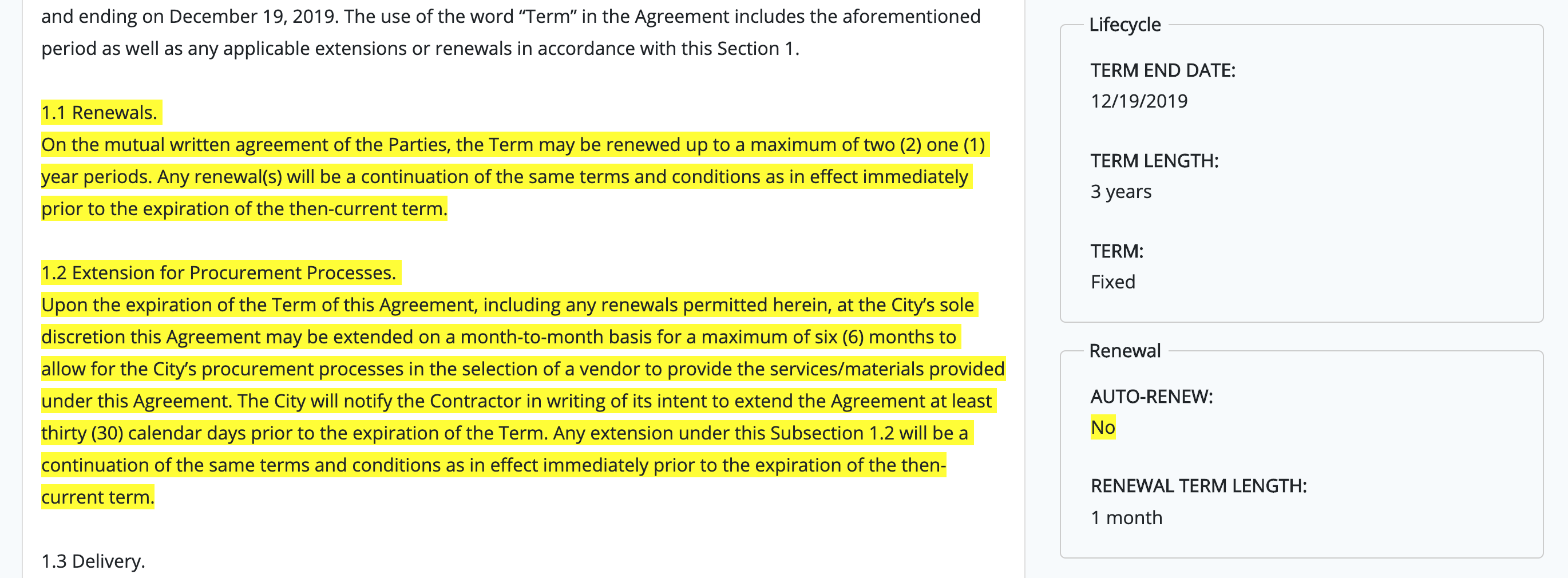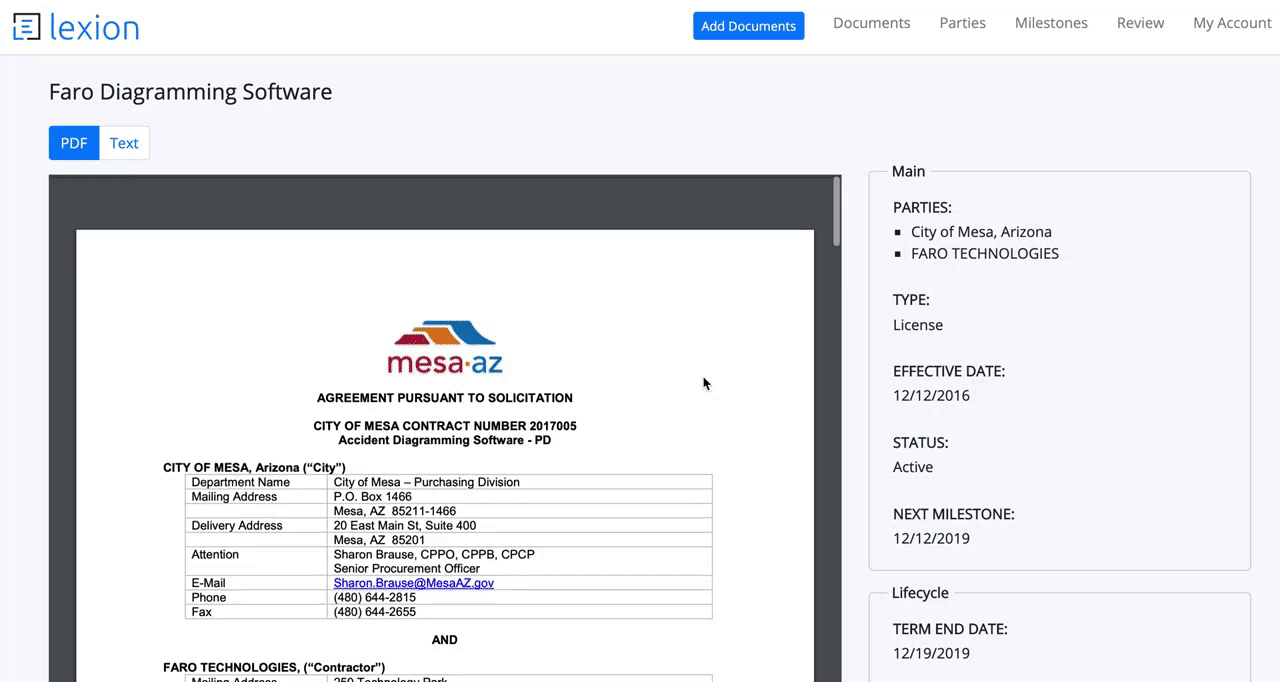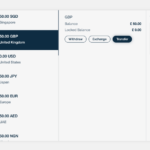Lexion raises $4.2M to bring AI to contract management
Contract management isn’t exactly an exciting subject, but it’s a real pain point for many companies. It also lends itself to automation, thanks to recent advances in machine learning and natural language processing. It’s no surprise then, that we see renewed interest in this space and that investors are putting more money into it. Earlier this week, Icertis raised a $115 million Series E round, for example, at a valuation of more than $1 billion. Icertis has been in this business for 10 years, though. On the other end of the spectrum, contract management startup Lexion today announced that it has raised a $4.2 million seed round led by Madrona Venture Group and law firm Wilson Sonsini Goodrich & Rosati, which was also one of the first users of the product.
Lexion was incubated at the Allen Institute for Artificial Intelligence (AI2), one of the late Microsoft co-founders’ four scientific research institutes. The company’s co-founder and CEO, Gaurav Oberoi, is a bit of a serial entrepreneur, whose first startup, BillMonk, was first featured on TechCrunch back in 2006. His second go-around was Precision Polling, which SurveyMonkey then acquired shortly after it launched. Oberoi founded the company together with former Microsoft research software development engineering lead Emad Elwany and engineering veteran James Baird.
“Gaurav, Emad, and James are just the kind of entrepreneurs we love to back: smart, customer obsessed and attacking a big market with cutting-edge technology,” said Madrona Venture Group managing director Tim Porter. “AI2 is turning out some of the best applied machine learning solutions, and contract management is a perfect example — it’s a huge issue for companies at every size and the demand for visibility into contracts is only increasing as companies face growing regulatory and compliance pressures.”
Contract management is becoming a bit of a crowded space, though, something Oberoi acknowledged. But he argues that Lexion is tackling a different market from many of its competitors.
“We think there’s growing demand and a big opportunity in the mid-market,” he said. “I think similar to how back in the 2000s, Siebel or other companies offered very expensive CRM software and now you have Salesforce — and now Salesforce is the expensive version — and you have this long tail of products in the mid-market. I think the same is happening to contracts. […] We’re working with companies that are as small as post-seed or post-Series A to a publicly traded company.”
Given that it handles plenty of highly confidential information, it’s no surprise that Lexion says that it takes security very seriously. “I think, something that all young startups that are selling into business or enterprise in 2019 need to address upfront,” Oberoi said. “We realized, even before we raised funding and got very serious about growing this business, that security has to be part of our DNA and culture from the get-go.” He also noted that every new feature and product iteration at Lexion goes through a security review.
Like most startups at this stage, Lexion plans to invest the new funding into building out its product — and especially its AI engine — and go-to-market and sales strategy.
Powered by WPeMatico
Huawei 5G indecision is hitting UK’s relations abroad, warns committee
The U.K.’s next prime minister must prioritize a decision on whether or not to allow Chinese tech giant Huawei to be a 5G supplier, a parliamentary committee has urged — warning that the country’s international relations are being “seriously damaged” by ongoing delay.
In a statement on 5G suppliers, the Intelligence and Security committee (ISC) writes that the government must take a decision “as a matter of urgency.”
Earlier this week another parliamentary committee, which focuses on science and technology, concluded there is no technical reason to exclude Huawei as a 5G supplier, despite security concerns attached to the company’s ties to the Chinese state, though it did recommend it be excluded from core 5G supply.
The delay in the U.K. settling on a 5G-supplier policy can be linked not only to the complexities of trying to weigh and balance security considers with geopolitical pressures but also ongoing turmoil in domestic politics, following the 2016 EU referendum Brexit vote — which continues to suck most of the political oxygen out of Westminster. (And will very soon have despatched two U.K. prime ministers in three years.)
Outgoing PM Theresa May, whose successor is due to be selected by a vote by Conservative Party members next week, appeared to be leaning toward giving Huawei an amber light earlier this year.
A leak to the press from a National Security Council meeting back in April suggested Huawei would be allowed to provide kit, but only for non-core parts of 5G networks — raising questions about how core and non-core are delineated in the next-gen networks.
The leak led to the sacking by May of the then defense minister, Gavin Williamson, after an investigation into confidential information being passed to the media in which she said she had lost confidence in him.
The publication of a government Telecoms Supply Chain Review, whose terms of reference were published last fall, has also been delayed — leading carriers to press the government for greater clarity last month.
But with May herself now on the way out, having agreed in May to step down as PM, the decision on 5G supply is on hold.
It will be down to either Boris Johnson or Jeremy Hunt, the two remaining contenders to take over as PM, to choose whether or not to let the Chinese tech giant supply U.K. 5G networks.
Whichever of the men wins the vote, they will arrive in the top job needing to give their full attention to finding a way out of the Brexit morass — with a mere three months til an October 31 Brexit extension deadline looming. So there’s a risk 5G may not seem as urgent an issue and a decision again be kicked back.
In its statement on 5G supply, the ISC backs the view expressed by the public-facing branch of the U.K.’s intelligence service that network security is not dependent on any one supplier being excluded from building it — writing that: “The National Cyber Security Centre… has been clear that the security of the UK’s telecommunications network is not about one company or one country: the ‘flag of origin’ for telecommunications equipment is not the critical element in determining cyber security.”
The committee argues that “some parts of the network will require greater protection” — writing that “critical functions cannot be put at risk” but also that there are “less sensitive functions where more risk can be carried”, albeit without specifying what those latter functions might be.
“It is this distinction — between the sensitivity of the functions — that must determine security, rather than where in the network those functions are located: notions of ‘core’ and ‘edge’ ate therefore misleading in this context,” it adds. “We should therefore be thinking of different levels of security, rather than a one size fits all approach, within a network that has been built to be resilient to attack, such that no single action could disable the system.”
The committee’s statement also backs the view that the best way to achieve network resilience is to support diversity in the supply chain — i.e. by supporting more competition.
But at the same time it emphasizes that the 5G supply decision “cannot be viewed solely through a technical lens — because it is not simply a decision about telecommunications equipment.”
“This is a geostrategic decision, the ramifications of which may be felt for decades to come,” it warns, raising concerns about the perceptions of U.K. intelligence sharing partners by emphasizing the need for those allies to trust the decisions the government makes.
It also couches a U.K. decision to give Huawei access a risk by suggesting it could be viewed externally as an endorsement of the company, thereby encouraging other countries to follow suit — without paying the full (and it asserts vitally) necessary attention to the security piece.
“The UK is a world leader in cyber security: therefore if we allow Huawei into our 5G network we must be careful that that is not seen as an endorsement for others to follow. Such a decision can only happen where the network itself will be constructed securely and with stringent regulation,” it writes.
The committee’s statement goes on to raise as a matter of concern the U.K.’s general reliance on China as a technology supplier.
“One of the lessons the UK Government must learn from the current debate over 5G is that with the technology sector now monopolised by such a few key players, we are over-reliant on Chinese technology — and we are not alone in this, this is a global issue. We need to consider how we can create greater diversity in the market. This will require us to take a long term view — but we need to start now,” it warns.
It ends by reiterating that the debate about 5G supply has been “unnecessarily protracted” — pressing the next U.K. prime minister to get on and take a decision “so that all concerned can move forward.”
Powered by WPeMatico
Tiny UK startup takes on Google’s Wing in the race to a drone traffic control system
A future where drones can easily and cheaply do many useful things such as deliver packages, undertake search and rescue missions and deliver urgent medical supplies, not to mention unclogging our roads with flying taxis, seems like a future worth shooting for. But before all this can happen, we need to make sure the thousands of drones in the sky are operating safely. A drone needs to be able to automatically detect when entering into the flight path of another drone, manned aircraft or restricted area and to alter its course accordingly to safely continue its journey. The alternative is the chaos and danger of the recent incidences of drones buzzing major airports, for instance.
There is a race on to produce just such a system. Wing LLC, an offshoot of the Alphabet / Google-owned X company, has announced a platform it calls OpenSky that it hopes will become the basis for a full-fledged air-traffic control system for drones. So far, it’s only been approved to manage drone flights in Australia, although it is also working on demonstration programs with the U.S. Federal Aviation Administration.
But this week, Altitude Angel, a U.K.-based startup backed by Seraphim Capital and with $4.9 million in funding, has launched its own UTM (Unmanned Traffic Management) system.
Its Conflict Resolution System (anti-collision) is basically an automatic collision-avoidance technology. This means that any drone flying beyond the line of sight will remain safe in the sky and not cross existing flight plans or into restricted areas. By being automated, Altitude Angel says this technology will prevent any mid-air collisions, simply because by knowing where everything else is in the sky, there’ll be no surprises.
Altitude Angel’s CRS has both “strategic” and “tactical” aspects.
The strategic part happens during the planning stages of a flight, i.e. when someone is submitting flight plans and requesting airspace permission. The system analyses the proposed route and cross-references it with any other flight plans that have been submitted, along with any restricted areas on the ground, to then propose a reroute to eliminate any flight-plan conflicts. Eventually, what happens is that a drone operator does this from an app on their phone, and the approval to flight is automated.
The next stage is tactical. This happens while the drone is actually in flight. The dynamic system continuously monitors the airspace around the aircraft both for other aircraft or for changes in the airspace (such as a temporary flight restriction around a police incident) and automatically adjusts the route.
The key aspect of this CRS is that drones and drone pilots can store flight plans with a globally distributed service without needing to exchange private or potentially sensitive data with each other while benefiting from an immediate pre-flight conflict resolution advice.
Altitude Angel CEO and founder Richard Parker says: “The ability for drones and automated aircraft to strategically plan flights, be made aware of potential conflict and alter their route accordingly is critical in ensuring safety in our skies. This first step is all about pre-flight coordination, between drone pilots, fleet operators and other UTM companies. Being able to predict and resolve conflict mid-flight by providing appropriate and timely guidance will revolutionize automated flight. CRS is one of the critical building blocks on which the drone and automated flight industries will grow.”
Altitude Angel won’t be the last to unveil a CRS of this type, but it’s instructive that there are startups confident of taking on the mighty Google and Amazon — which also has similar drone delivery plans — to achieve this type of platform.
Powered by WPeMatico
VertoFX raises $2M for its African and EM currency trading platform
VertoFX, an Africa and emerging markets-focused currency trading and payment startup, has raised a $2.1 million seed round, led by Accelerated Digital Ventures.
The London-based company, with a subsidiary in Lagos, Nigeria, has created a platform that allows businesses and banks to exchange and make payments in exotic foreign currencies that don’t often convert or trade conveniently across businesses or banks.
For example, South Africa’s Rand is Africa’s most convertible and traded currency — with lower spreads and transaction costs — while currencies of countries such as Ethiopia or Egypt may be difficult or expensive to trade or transact B2B payments.
“That’s the reason we are utilizing technology to create a marketplace model and price discovery to create liquidity for these currencies,” VertoFX founder Ola Oyetayo told TechCrunch.
There are around 40 global currencies that are considered exotic or illiquid, most of them in frontier markets in Asia, Africa and the Middle-East, according to Oyetayo.
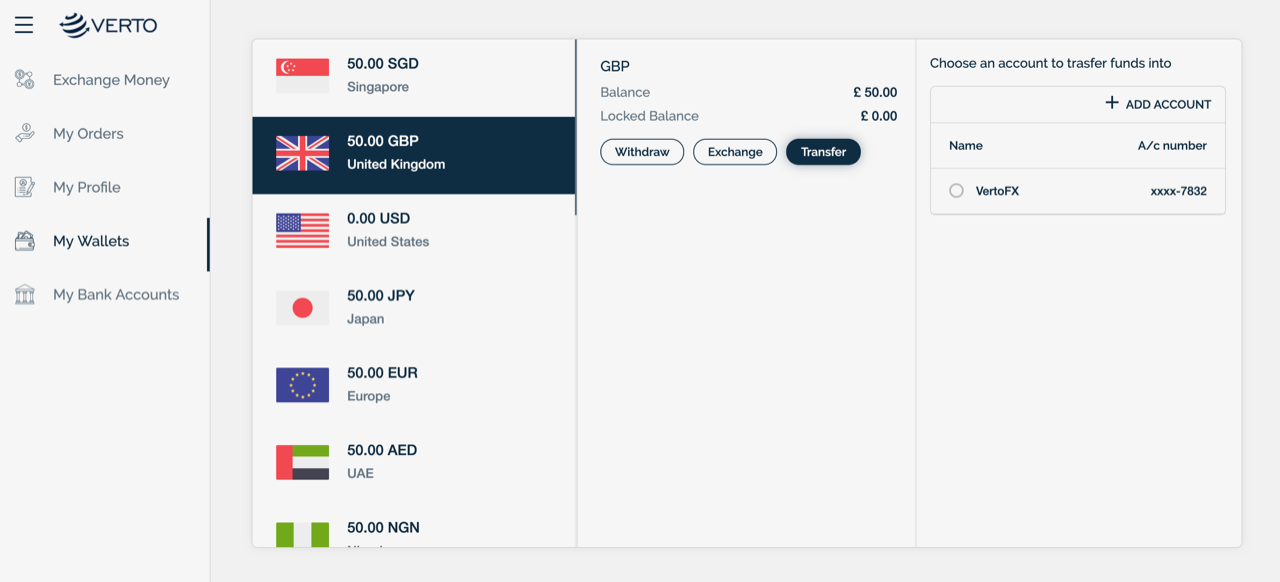 And there’s a revenue opportunity to creating a convenient online marketplace for trading and payments in these currencies.
And there’s a revenue opportunity to creating a convenient online marketplace for trading and payments in these currencies.
“Our research says there’s about $400 billion being done by small and medium-scale businesses in Africa alone in transactional volume on an annual basis. If we take 1% of that as a commission or transaction fee, that’s a $4 billion addressable market, just in the continent,” said Oyetayo.
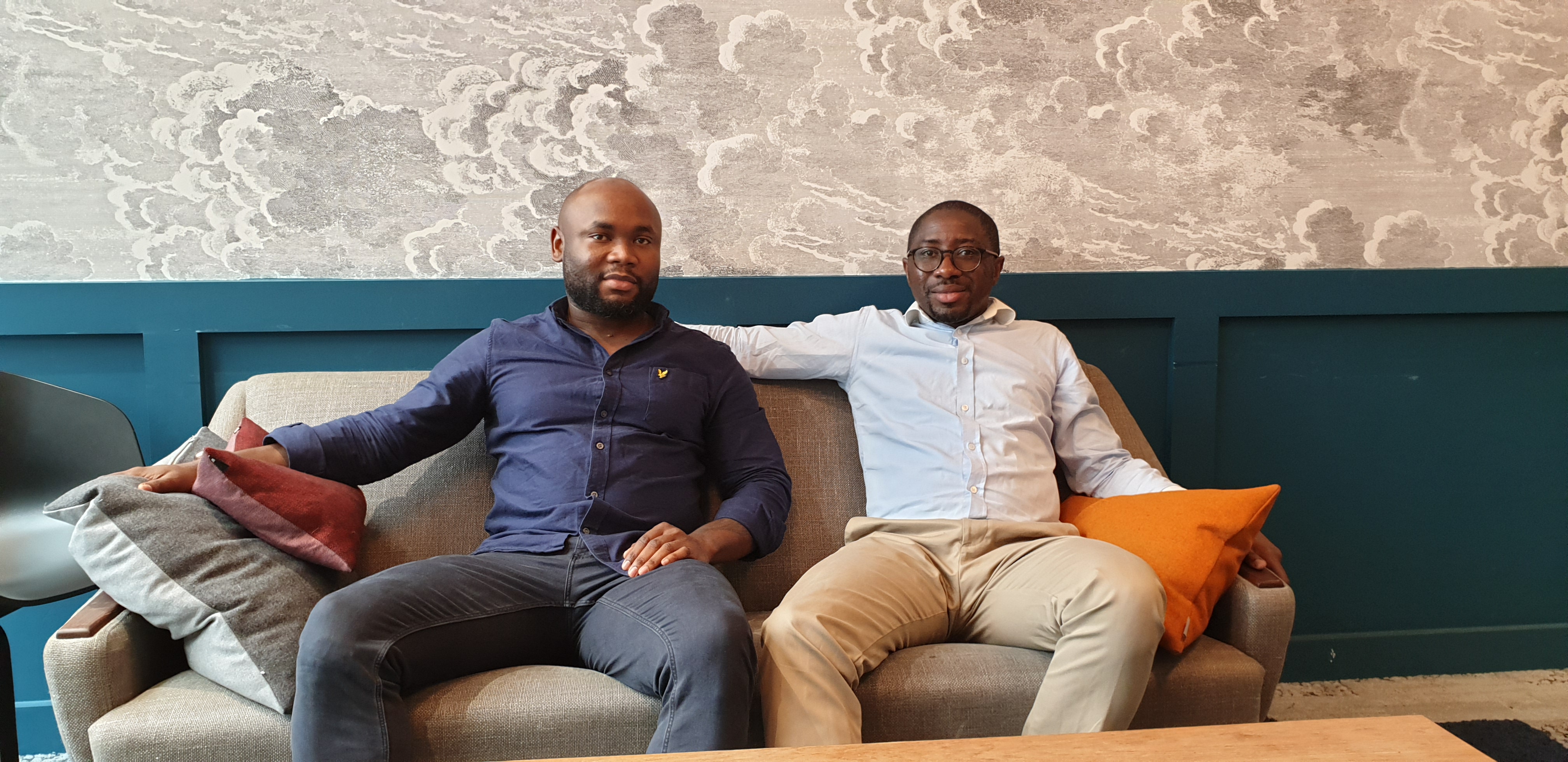 VertoFX was founded in 2017 by Oyetayo and Anthony Oduwole — both ex-global bankers born in Nigeria. The company was part of Y Combinator’s 2019 winter cohort and processed around $7 million in transaction volume last month, according to Oyetayo.
VertoFX was founded in 2017 by Oyetayo and Anthony Oduwole — both ex-global bankers born in Nigeria. The company was part of Y Combinator’s 2019 winter cohort and processed around $7 million in transaction volume last month, according to Oyetayo.
VertoFX is registered as a payment services provider with the U.K.’s Financial Conduct Authority. Current clients include several undisclosed banks and San Francisco-based payment venture Flutterwave.
VertoFX doesn’t release revenue figures, but confirmed it earns a commission, or spread, on each transaction processed on its platform. There are currently 19 currencies on the platform and the ability to settle in 120 countries, including China and the U.S.
VertoFX is also moving into offering market research — toward potential subscription services — on the currencies it trades, according to Oyetayo.
The startup will use the round for platform development, expanding the currencies and gaining licenses in new countries. “We’ll also use the round for hiring, primarily in compliance and regulator type roles,” said Oyetayo. VertoFX already has a developer team in India and is looking at local developer talent for its Africa offices.
ADV’s Ryan Proctor confirmed the VC firm’s lead on the investment round, which also included participation from YC and several local angel investors in Africa, Oyetayo told TechCrunch.
On the possibility of becoming acquired by a big bank, VertoFX isn’t so interested, according to Oyetayo.
“We both come from big banks and if we’d wanted to go down that route we’d have developed this more as a software as a service platform,” he said.
“We’re playing the long game here, and I don’t think acquisition is the end game,” he said.
Powered by WPeMatico
Tesla’s new V3 Supercharger can charge up to 1,500 electric vehicles a day
Tesla has opened a massive next-generation electric vehicle charging station in Las Vegas that combines the company’s core products into one sustainable energy ecosystem, fulfilling a vision CEO Elon Musk laid out nearly three years ago.
The new V3 Supercharger, which supports a peak rate of up to 250 kilowatts, is designed to dramatically cut charging times for its electric vehicles. Tesla unveiled its first V3 Supercharger in March at its Fremont, Calif. factory. A second V3 Supercharger is located in Hawthorne, Calif., near the Tesla Design Studio. Both of these locations, which were initially used as test sites, lack two key Tesla products.
This new location in Las Vegas is considered the first V3 Supercharger. It’s notable, and not just because of the size — there are 39 total chargers in all. This V3 Supercharger also uses Tesla solar panels and its Powerpack batteries to generate and store the power needed to operate the chargers. The result is a complete system that generates its own energy and passes it along to thousands of Tesla vehicles.
The new Supercharger, located off the Las Vegas Strip, below the High Roller on the LINQ promenade, was built on Caesars Entertainment property. The site is part of Caesars Entertainment’s goal to reduce greenhouse gas emissions 30% by 2025.
There are caveats to the capabilities of this Supercharger station. Only one Tesla vehicle — the Model 3 Long Range iteration — can charge at the peak rate of 250 kW. The 250 kW results in up to 180 miles of range added to the battery in 15 minutes on a Model 3 Long Range.
The company’s new Model S and Model X vehicles can charge up to a 200 kW rate.
However, even older Model S and X vehicles and more basic versions of the Model 3 will experience faster charging rates at this location because there is no power sharing, a standard practice at Tesla’s other charging stations.
Improvements to charging times are critical for the company as it sells more Model 3 vehicles, its highest-volume car. Wait times at some popular Supercharger stations can be lengthy. Early adopters might have been content to wait, but as new Tesla customers come online, that patience could dwindle. And as more of these V3 Superchargers come online, potential customers might be encouraged to buy the pricier long-range version Model 3.
Tesla has said in the past that these improvements will allow the Supercharger network to serve more than twice as many vehicles per day at the end of 2019 compared with today.
The V3 is not a retrofit of the company’s previous generations. It’s an architecture shift that includes a new 1 MW power cabinet, similar to the company’s utility-scale products, and a liquid-cooled cable design, which enables charge rates of up to 1,000 miles per hour. Tesla uses air-cooled cables on V2 Superchargers.
Powered by WPeMatico
Hardware startups take center stage for Hardware Battlefield at TC Shenzhen
Software grabs so much attention that it even has its own catchphrase — there’s an app for that. It’s not a bad thing, but we know nothing happens without hardware. That’s why we’re hunting for the best early-stage hardware startups to take center stage at Hardware Battlefield at TC Shenzhen on November 11-12 in China.
Apply here to compete in TC Hardware Battlefield 2019, our hardware-focused pitch competition. If selected, you’ll go head-to-head against some of the world’s most innovative hardware makers for a shot at $25,000. What’s more, you’ll pitch your creations to the world’s top investors. Imagine what that kind of exposure could do for your bottom line.
This is our fifth Hardware Battlefield and our first in China. Shenzhen has a global reputation for the support it offers hardware startups through a combination of accelerators, rapid prototyping and world-class manufacturing. We’re thrilled to collaborate with our partner TechNode to host TC Hardware Battlefield 2019 as part of the larger TechCrunch Shenzhen that runs November 9-12.
Any early-stage hardware startup — from any country — can apply to this competition. We’ve seen an impressive range of hardware in previous Battlefields, including robotic arms, food testing devices, malaria diagnostic tools, smart socks for diabetics and e-motorcycles. Show us what you’ve got!
Meet the minimum requirements listed below, and you’re qualified for consideration:
- Fill out the TC Hardware Battlefield 2019 application before the August 14 deadline.
- You must have a minimally viable product to demo onstage
- Your product has received little if any, press coverage to date
- Your product must be a hardware device or component
If you’ve never experienced one of our Battlefield pitch competitions, you’re in for the ride of a lifetime. Here’s how this Hardware Battlefield works.
The vetting process is very selective, and TechCrunch editors thoroughly review every qualified application. They’ll pick 10-15 outstanding hardware startups to compete. Every participating team receives extensive coaching from TechCrunch editors wise in the ways of Battlefield competitions. How extensive? Try six weeks of training that leaves you ready to step on the main stage in front of a panel of judges comprised of expert VCs, founders and technologists.
Each team has just six minutes to pitch and demo their products and then respond to an in-depth Q&A from the judges. One team will rise above the rest to become the Hardware Battlefield champion and take home a check for $25,000.
Even if you don’t win the whole shooting match, you’ll walk away with invaluable — some might say life-changing — media and investor exposure. Of course, we’ll capture the entire event on video and publish it on TechCrunch to a global audience.
Hardware Battlefield at TC Shenzhen takes place on November 11-12. Don’t miss your chance to launch your hardware startup on the world’s most famous tech stage. Apply today!
Is your company interested in sponsoring or exhibiting at Hardware Battlefield at TC Shenzhen? Contact our sponsorship sales team by filling out this form.
Powered by WPeMatico
VMware acquires ML acceleration startup Bitfusion
VMware today announced that it has acquired Bitfusion, a former participant in our Startup Battlefield competition. Bitfusion was one of the earliest companies to help businesses accelerate their complex computing workloads on GPUs, FPGAs and ASICs. In its earliest iteration, over four years ago, the company’s focus was less on AI and machine learning and more on other areas of high-performance computing, but, unsurprisingly, that shifted as the interested in AI and ML increased in recent years.
VMware will use Bitfusion’s technology, which is vendor- and hardware-agnostic, to bring similar capabilities to its customers. Specifically, it plans to integrate Bitfusion into its vSphere platform.
“Once closed, the acquisition of Bitfusion will bolster VMware’s strategy of supporting AI- and ML-based workloads by virtualizing hardware accelerators,” writes Krish Prasad, senior vice president and general manager of VMware’s Cloud Platform Business Unit. “Multi-vendor hardware accelerators and the ecosystem around them are key components for delivering modern applications. These accelerators can be used regardless of location in the environment – on-premises and/or in the cloud.”
Prasad also notes that to get the most out of hardware accelerators like GPUs, most enterprises deploy them on bare metal. VMware, however, argues that this leads to poor utilization and poor efficiencies (as it would, of course, given that it is in the business of virtualization). “This provides a perfect opportunity to virtualize them—providing increased sharing of resources and lowering costs,” writes Prasad.
The two companies did not disclose the price of the acquisition. Bitfusion had raised $5 million in 2017 and a smaller, strategic investment from Samsung Ventures in 2018.
Powered by WPeMatico
Submittable raises $10M to help publishers and other organizations manage their submissions
Submittable is announcing that it has raised $10 million in Series B funding.
When I first wrote about the company in 2012, it was focused on helping literary magazines manage their submissions — useful, but maybe not the kind of thing that venture capitalists write big checks for.
Since then, Submittable raised a $5 million Series A and expanded by helping companies in a number of industries manage their submissions and applications. Co-founder and CEO Michael FitzGerald said the company has built products for four main verticals (corporate, academic, philanthropy and publishing) and has signed up big customers like AT&T, HBO, Conde Nast, Harvard and MIT.
And while publishing may no longer be the main focus, FitzGerald — a published novelist himself — noted that “in the publishing world, we’re pretty much the way you do it.” I’ve certainly been seeing more Submittable submissions pages, (although FitzGerald acknowledged that the service hasn’t quite taken hold among science fiction magazines).
He also said the product has been getting increasingly sophisticated, for example, allowing a publisher to review and rank submissions based on very specific qualities like sentence structure and voice.

Besides expanding into additional verticals and launching on mobile, one of FitzGerald’s main goals it to create what he called “ZipRecruiter for Opportunities,” a marketplace that uses Submittable data to connect individuals and organizations that seem like a good fit, whether they’re writers and magazines, scholarships and students or any other pairing for “any opportunity that isn’t a job.”
Submittable is based in Missoula, Mont., and the round was led by Next Coast Ventures, a firm that invests in startups outside the big coastal tech hubs. (Previous investors True Ventures and Next Frontier also participated.) Next Coast co-founder and managing director Michael Smerklo is joining the startup’s board of directors.
“Submittable is a perfect example of what is possible outside Silicon Valley,” Smerklo said in a statement. “The platform is modernizing the often painful undertaking of managing the submission process and leveraging that data for genuine opportunity creation.”
FitzGerald (who’s spoken elsewhere about his experience working as a startup CEO while also facing a Stage 4 cancer diagnosis) said the plan is to expand the Submittable team from 88 to 240 people by the end of 2020. He acknowledged that the location has created some challenges in hiring, particularly when it comes to experienced executives, but he said he’s been assisted by the fact that ClassPass and OnxMaps have also opened offices in Missoula.
Plus, he said that one of the most effective tactics involves searching LinkedIn for executives who went to high school in Missoula between 1985 and 2000: “Everyone is looking for a way home.”
Powered by WPeMatico
Rent the Backyard wants to build a studio apartment in your yard
Rent the Backyard is one of the rare startups with a name that perfectly suits what it does.
The company, which is part of Y Combinator’s current batch, builds studio apartments in homeowners’ backyards, which are then rented out for income.
Of course, if you already own a house with a yard, you could theoretically do this for yourself, without getting a startup involved, but co-founder Brian Bakerman told me, “The goal is to have no headaches for the homeowners.”
That means Rent the Backyard works with a partner to build the apartment, finances the construction, lists the property, selects the tenant, collects the rent and serves as the landlord. In exchange for all that, it has an ownership stake in the unit and keeps 50% of the rent.
The startup also handles the permitting, which co-founder Spencer Burleigh said has become much easier with recent changes in California law. In fact, he pointed to stories about how these changes have led to skyrocketing applications (16 in 2016, 350 in 2018) to build “in-law” units in San Jose, which is where the startup is focused for now.
Bakerman said that many homeowners simply can’t afford the upfront cost of building these units, so by providing the financing, Rent the Backyard can unlock new income and make home ownership more affordable. At the same time, it’s also helping renters by creating more apartments.
Of course, for a homeowner, that means giving up a big piece of your backyard (which must be at least 30 feet by 30 feet in size), but Bakerman said that many yards are “underutilized” anyway.
“In places like the Bay Area … people are spending a ridiculous amount on their homes,” he added. “They often can’t afford those lifestyles, but everyone wants to attain home ownership.”
The company’s website includes a calculator of how much rental income you might earn, and it says that most owners will be able to make more than $10,000 of additional income each year.
Over time, Rent the Backyard will give the homeowner an increasing share of equity in the apartment, until they own it completely after 30 years. Homeowners also can buy out the startup’s equity and take full ownership at any time (which they’ll need to do if they sell their home and move out).
To be clear, Rent the Backyard hasn’t actually built any apartments yet, but it’s already signed up construction partners, and the goal is to get 10 units permitted and ready for construction by the end of the summer.
“It’s a pretty fast process,” Bakerman said. “It could just be a handful of weeks before we’re able to start building” — and because the units use prefabricated construction methods, the actual building could take as little as a week and a half.
Powered by WPeMatico
How Carl Pope helped drive a $500 million pledge to push the U.S. “Beyond Carbon” (Part 2)
Billionaire businessman and philanthropist Michael Bloomberg recently pledged to rapidly spend $500 million in a bid to push the U.S. “Beyond Carbon,” aiming to end this country’s use of coal and natural gas power in a generation or less.
In another recent piece, I featured an in-depth interview with Carl Pope, the veteran environmental leader who has essentially been the inspirational force behind Bloomberg’s evolution. The former New York City Mayor had never given a major gift to environmental causes as of a decade or so ago, until Pope “convinced” him to get involved.

My previous piece was an attempt to understand the ethical vision influencing Bloomberg’s work, by looking at Pope’s personal story and the history of the environmental movement he has helped to shape. Below, Pope joins me again to look at the details of Bloomberg’s “Beyond Carbon” plan, including how he was able to persuade Bloomberg to take it on, and some areas of controversy that could arise as the $500 million is distributed.
Greg Epstein: You and Michael Bloomberg met around a decade ago or so, right?
Carl Pope: About 12 years ago, actually. 2007.
Epstein: Bloomberg had never given a major gift to an environmental group before he met you, and, as he writes in the book, you “convinced him” to get massively involved, to the tune now of many hundreds of millions of dollars. What do you think it is about you, the way that you approach things, or the work you do that made the two of you, in this relatively unlikely partnership, work so well?
Pope: We both like big ideas, and we both like to pursue them very pragmatically. We set very high expectations for what we want to get, and we’re willing to take necessarily small steps to get there. That’s one thing.
The second thing is, my original environmental frame was air pollution, [which] I worked on the first seven or eight years I was an environmentalist. Mike is a big public health advocate. So the fact that I was talking about saving people’s lives made a lot of sense to him.
Epstein: He talked about how you ‘showed him the numbers,’ back in 2011, on just how deadly coal actually is.
Pope: Yeah, that was the deal sealer.
Epstein: Interpersonally, what the interactions between you and him like?
Pope: We’re both public figures who are actually somewhat introspective, and so it works.
Epstein: I’ve read the “Beyond Carbon” plans as they’re presented by the Bloomberg organization. They do seem quite promising as far as broad, sweeping PR statements go.
But whether or not they will work is all in the details, right? You’re a detail-oriented person, as you just mentioned, so, what are some of the practical steps the plan calls for that you think deserve the most attention, beyond the headlines?
Pope: In A Climate of Hope, Mike and I articulated an approach to climate in which we gave our reasons for thinking that most climate leadership is going to come not from national governments but from businesses, cities, provinces, civic organizations, from the bottom up.
Powered by WPeMatico

